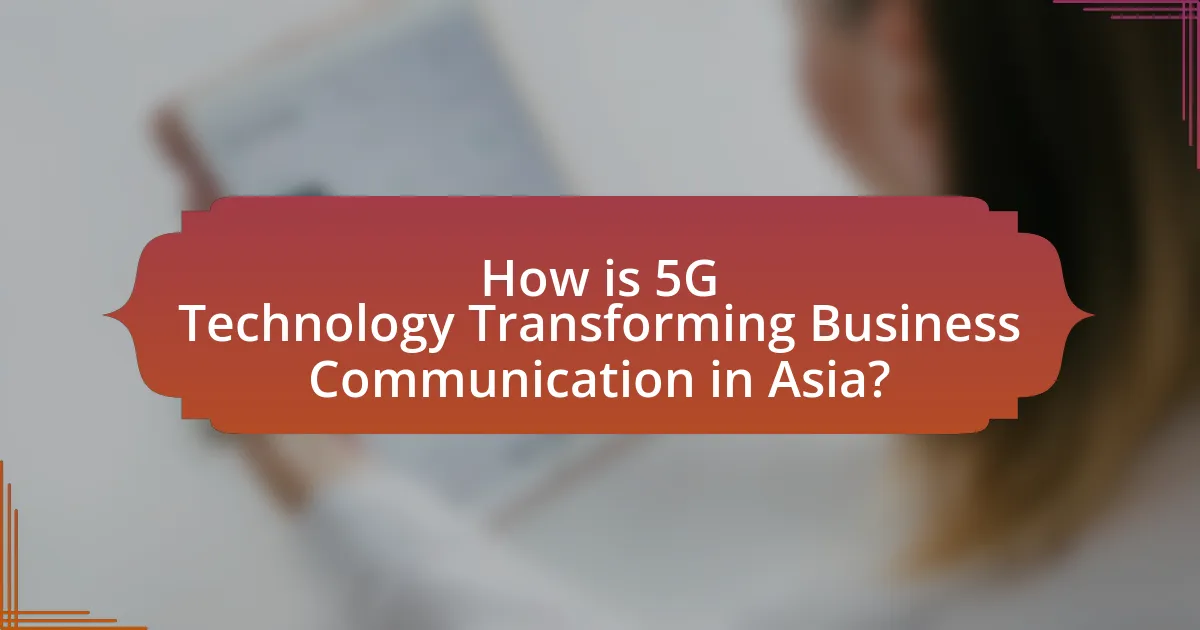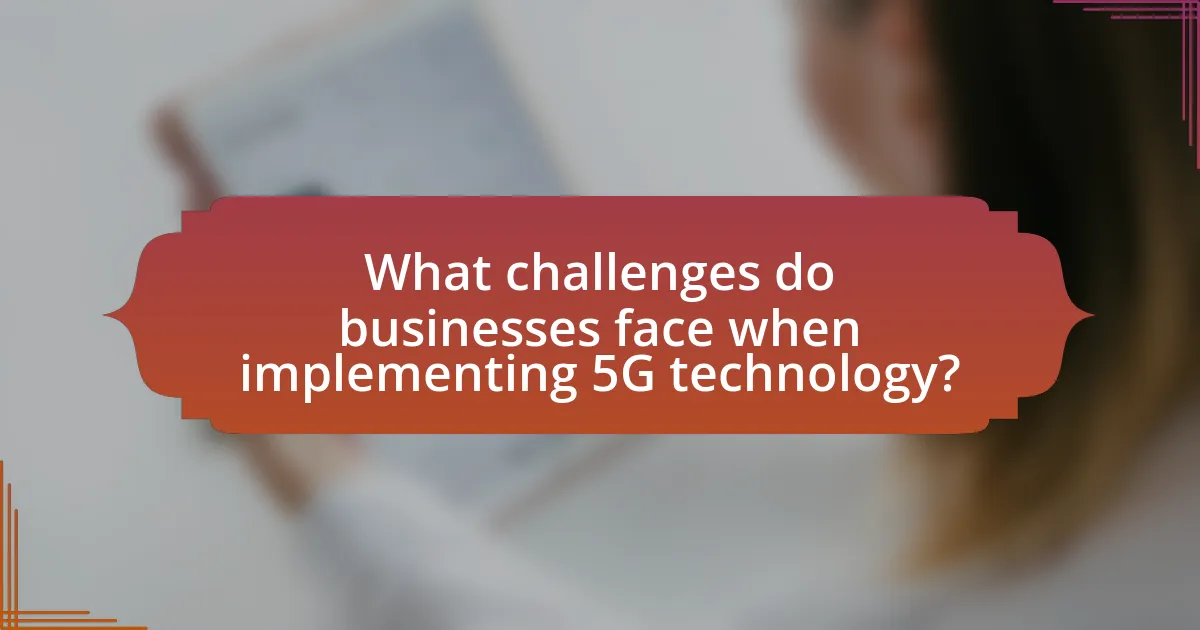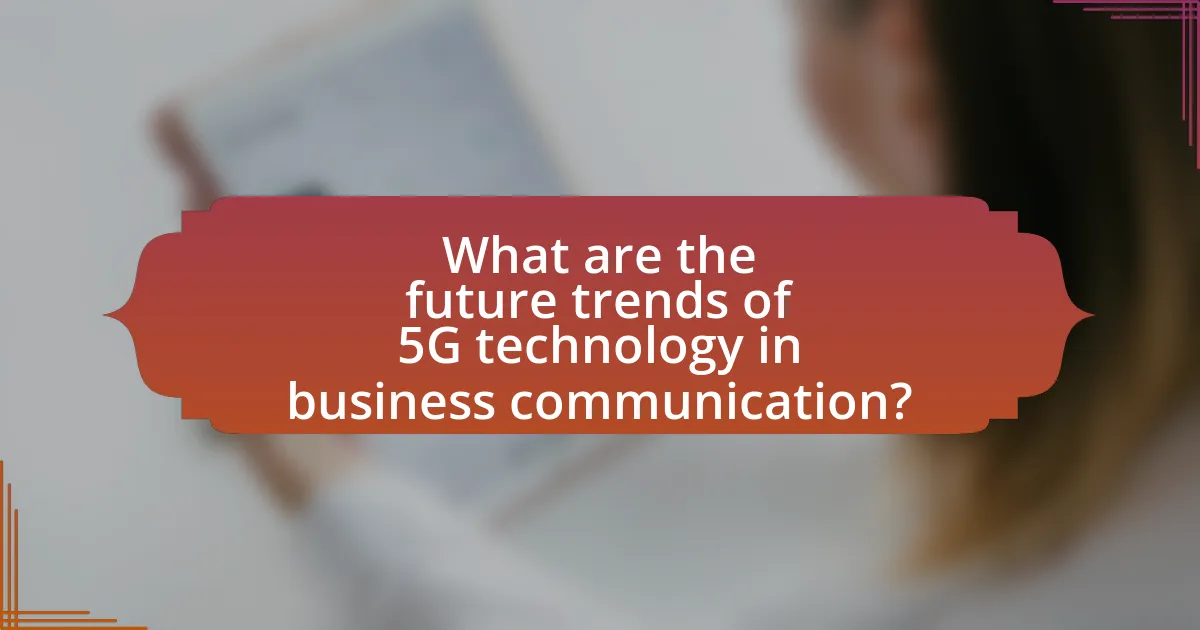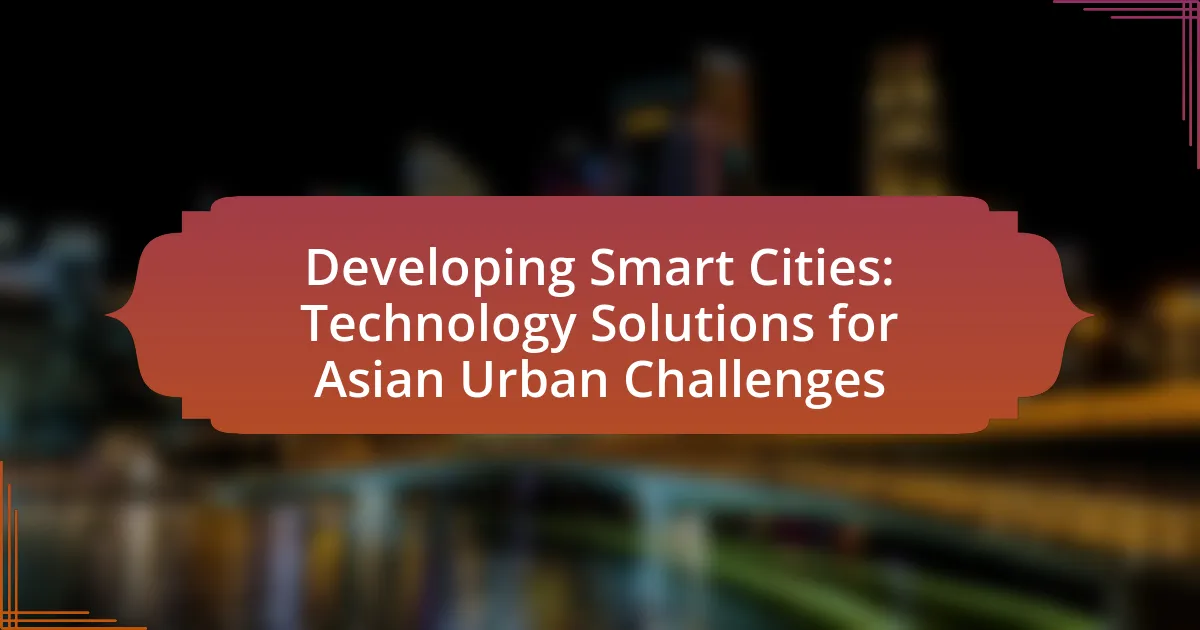5G technology is revolutionizing business communication in Asia by providing faster data transfer, lower latency, and enhanced connectivity. This advancement enables real-time communication tools, such as video conferencing and cloud-based applications, which improve collaboration and decision-making. Key features of 5G, including increased speed and capacity, facilitate the Internet of Things (IoT), allowing businesses to streamline operations and enhance productivity. However, challenges such as high infrastructure costs and regulatory hurdles must be addressed for successful implementation. The article explores the impact of 5G on business communication, its competitive advantages, and strategies for overcoming deployment challenges.

How is 5G Technology Transforming Business Communication in Asia?
5G technology is transforming business communication in Asia by enabling faster data transfer, lower latency, and enhanced connectivity. This advancement allows businesses to implement real-time communication tools, such as video conferencing and cloud-based applications, which improve collaboration and decision-making processes. For instance, a study by GSMA indicates that 5G can provide download speeds up to 10 Gbps, significantly enhancing the efficiency of data-heavy applications. Additionally, the widespread adoption of 5G facilitates the Internet of Things (IoT), allowing businesses to connect and manage devices seamlessly, leading to improved operational efficiency and innovative service offerings.
What are the key features of 5G technology that impact business communication?
The key features of 5G technology that impact business communication include enhanced speed, reduced latency, increased connectivity, and improved capacity. Enhanced speed allows for faster data transfer rates, enabling real-time communication and collaboration among teams, which is crucial for businesses operating in fast-paced environments. Reduced latency, which can be as low as one millisecond, facilitates instantaneous responses in applications such as video conferencing and remote work, significantly improving user experience. Increased connectivity supports a higher number of devices per square kilometer, allowing businesses to implement IoT solutions effectively, which can streamline operations and enhance productivity. Improved capacity ensures that networks can handle more data traffic without congestion, allowing for seamless communication even during peak usage times. These features collectively enable businesses to operate more efficiently and adapt to changing market demands.
How does increased speed enhance communication efficiency?
Increased speed enhances communication efficiency by significantly reducing latency and enabling faster data transfer. This allows for real-time interactions, which are crucial in business environments where timely decision-making is essential. For instance, 5G technology can achieve download speeds up to 10 Gbps, compared to 4G’s maximum of 1 Gbps, facilitating quicker access to information and seamless collaboration among teams. Studies show that businesses leveraging 5G can improve operational efficiency by up to 30%, as faster communication leads to quicker responses and enhanced productivity.
What role does low latency play in real-time communication?
Low latency is crucial in real-time communication as it ensures minimal delay between the transmission and reception of data, enabling instantaneous interactions. In the context of 5G technology, which offers latency as low as 1 millisecond, this rapid response time facilitates seamless video conferencing, live streaming, and interactive applications essential for business communication. Studies indicate that reduced latency enhances user experience and productivity, as evidenced by a report from the International Telecommunication Union, which highlights that lower latency can significantly improve the effectiveness of remote collaboration tools.
Why is 5G adoption critical for businesses in Asia?
5G adoption is critical for businesses in Asia because it enables faster data transmission, lower latency, and greater connectivity, which are essential for digital transformation. The technology supports advanced applications such as IoT, AI, and real-time analytics, allowing companies to enhance operational efficiency and customer engagement. For instance, a report by GSMA indicates that 5G could contribute $1 trillion to Asia’s economy by 2030, highlighting its potential to drive innovation and competitiveness in the region.
What competitive advantages does 5G provide to Asian businesses?
5G provides Asian businesses with competitive advantages such as enhanced speed, lower latency, and increased connectivity. These factors enable faster data transfer, which is crucial for real-time applications like remote work, telemedicine, and smart manufacturing. For instance, 5G networks can achieve speeds up to 10 Gbps, significantly surpassing 4G capabilities, which allows businesses to process large amounts of data quickly. Additionally, the reduced latency of 1 millisecond or less facilitates instantaneous communication, improving operational efficiency and customer service. Furthermore, 5G supports a higher density of connected devices, enabling the Internet of Things (IoT) to flourish, which can lead to innovative business models and improved supply chain management. These advantages position Asian businesses to leverage technology for growth and competitiveness in the global market.
How does 5G facilitate innovation in business communication tools?
5G facilitates innovation in business communication tools by providing significantly higher data speeds, lower latency, and increased connectivity. These enhancements enable real-time collaboration, seamless video conferencing, and the integration of advanced technologies like augmented reality and artificial intelligence into communication platforms. For instance, 5G networks can support up to one million devices per square kilometer, allowing businesses to implement IoT solutions that enhance operational efficiency and customer engagement. Additionally, a study by Ericsson indicates that 5G can reduce latency to as low as one millisecond, which is crucial for applications requiring instant feedback, such as remote work tools and customer service chatbots.

What challenges do businesses face when implementing 5G technology?
Businesses face several challenges when implementing 5G technology, including high infrastructure costs, regulatory hurdles, and the need for skilled personnel. The deployment of 5G requires significant investment in new infrastructure, such as base stations and fiber optics, which can strain budgets, especially for smaller companies. Regulatory challenges arise from the need to secure permits and comply with local laws, which can delay implementation. Additionally, the transition to 5G necessitates a workforce skilled in new technologies, creating a talent gap that businesses must address to fully leverage 5G capabilities. These challenges can hinder the speed and effectiveness of 5G adoption in enhancing business communication.
What are the infrastructural challenges of 5G deployment in Asia?
The infrastructural challenges of 5G deployment in Asia include inadequate existing infrastructure, high costs of new installations, and regulatory hurdles. Many Asian countries face a lack of sufficient fiber optic networks, which are essential for supporting 5G technology, leading to delays in deployment. Additionally, the financial burden of upgrading or building new towers and base stations can be significant, particularly in densely populated urban areas. Regulatory challenges, such as obtaining permits and navigating different national policies, further complicate the rollout process. For instance, a report by the International Telecommunication Union highlights that countries like India and Indonesia struggle with these issues, impacting their ability to implement 5G effectively.
How do regulatory issues affect 5G rollout in different countries?
Regulatory issues significantly impact the 5G rollout in different countries by influencing the speed and scope of deployment. For instance, in the United States, the Federal Communications Commission (FCC) has streamlined the approval process for 5G infrastructure, enabling faster deployment compared to countries with more stringent regulations, such as India, where bureaucratic hurdles and spectrum allocation delays have slowed progress. Additionally, countries like China have implemented state-led initiatives that prioritize rapid 5G expansion, resulting in extensive coverage and adoption. In contrast, European nations face varying regulatory frameworks that can either facilitate or hinder the rollout, as seen in Germany, where strict environmental regulations have delayed infrastructure development. These examples illustrate how regulatory environments shape the pace and effectiveness of 5G implementation globally.
What are the costs associated with transitioning to 5G technology?
The costs associated with transitioning to 5G technology include infrastructure investment, spectrum acquisition, and operational expenses. Infrastructure investment can range from $200 billion to $300 billion globally, as telecom companies need to upgrade existing networks and install new base stations to support 5G. Spectrum acquisition costs vary significantly by region; for example, in the United States, the Federal Communications Commission auctioned off 5G spectrum for over $80 billion. Additionally, operational expenses may increase due to the need for advanced technology and skilled personnel to manage the new systems. These financial commitments are essential for enabling the enhanced capabilities of 5G, which can significantly improve business communication and operational efficiency.
How can businesses overcome these challenges?
Businesses can overcome challenges related to 5G technology by investing in infrastructure upgrades and training employees on new systems. Upgrading infrastructure ensures compatibility with 5G networks, which can enhance communication speed and reliability. For instance, companies that have adopted 5G have reported up to 100 times faster data speeds compared to 4G, significantly improving operational efficiency. Additionally, providing training for employees on utilizing 5G capabilities can maximize the technology’s benefits, as studies show that organizations with well-trained staff are 30% more likely to successfully implement new technologies.
What strategies can companies employ to ensure a smooth transition to 5G?
Companies can ensure a smooth transition to 5G by implementing a comprehensive strategy that includes upgrading infrastructure, training employees, and collaborating with telecom providers. Upgrading infrastructure involves investing in compatible hardware and software to support 5G technology, which is essential for maximizing performance and reliability. Training employees on new technologies and processes is crucial, as it enhances their ability to leverage 5G capabilities effectively. Collaborating with telecom providers allows companies to gain insights into best practices and access necessary resources for a seamless transition. According to a report by the GSMA, businesses that actively engage in these strategies are more likely to realize the full benefits of 5G, such as increased speed and improved connectivity, which are vital for enhancing business communication in Asia.
How can partnerships with telecom providers facilitate 5G adoption?
Partnerships with telecom providers can facilitate 5G adoption by leveraging their existing infrastructure and expertise to accelerate deployment and enhance service offerings. Telecom providers possess the necessary network capabilities, regulatory knowledge, and customer relationships that can streamline the rollout of 5G technology. For instance, collaborations between technology companies and telecom operators have led to faster implementation timelines; a report by GSMA indicates that regions with strong telecom partnerships have seen 5G networks deployed up to 30% quicker than those without such collaborations. This synergy not only reduces costs but also fosters innovation in applications and services that utilize 5G, ultimately driving broader adoption across various sectors.

What are the future trends of 5G technology in business communication?
The future trends of 5G technology in business communication include enhanced connectivity, increased data speeds, and the proliferation of Internet of Things (IoT) devices. Enhanced connectivity will enable seamless communication across various platforms, allowing businesses to operate more efficiently. Increased data speeds will facilitate real-time data transfer, which is crucial for applications such as video conferencing and remote collaboration. The proliferation of IoT devices will lead to smarter workplaces, where devices communicate autonomously, optimizing operations and reducing costs. According to a report by Ericsson, 5G is expected to support up to 1 million devices per square kilometer, significantly impacting business communication strategies in Asia.
How will 5G shape the future of remote work in Asia?
5G will significantly enhance remote work in Asia by providing faster internet speeds, lower latency, and improved connectivity. This technology enables seamless video conferencing, real-time collaboration, and access to cloud-based applications, which are essential for remote teams. For instance, 5G networks can deliver speeds up to 10 Gbps, compared to 4G’s maximum of 1 Gbps, allowing for high-definition video calls and large file transfers without delays. Additionally, the reduced latency of 5G, often below 10 milliseconds, facilitates instant communication, making remote work more efficient. As a result, businesses in Asia can leverage 5G to create more flexible work environments, attract talent from diverse locations, and enhance productivity.
What tools and platforms will emerge as a result of 5G technology?
5G technology will lead to the emergence of tools and platforms such as enhanced mobile broadband applications, IoT (Internet of Things) solutions, and real-time communication platforms. Enhanced mobile broadband will support high-definition video conferencing and augmented reality applications, improving remote collaboration in businesses. IoT solutions will enable smart devices to communicate seamlessly, optimizing operations and resource management. Real-time communication platforms will leverage low latency to facilitate instant messaging and video calls, enhancing customer service and team collaboration. These advancements are supported by the increased data transfer speeds and reduced latency that 5G technology provides, which are essential for the functionality of these tools and platforms.
How will 5G influence collaboration among remote teams?
5G will significantly enhance collaboration among remote teams by providing faster data transfer speeds, lower latency, and improved connectivity. This technology enables seamless video conferencing, real-time collaboration on cloud-based applications, and instant access to large files, which are critical for effective teamwork. For instance, 5G networks can achieve speeds up to 10 Gbps, compared to 4G’s maximum of 1 Gbps, allowing for high-definition video calls without lag. Additionally, the reduced latency of 5G, which can be as low as 1 millisecond, ensures that remote team members can communicate and collaborate in real-time, mimicking in-person interactions. These advancements facilitate a more integrated and productive work environment for remote teams, ultimately leading to enhanced efficiency and innovation in business communication across Asia.
What best practices should businesses follow to leverage 5G technology effectively?
To leverage 5G technology effectively, businesses should prioritize network readiness, invest in compatible infrastructure, and focus on data security. Network readiness ensures that the existing systems can handle the increased speed and capacity that 5G offers, which is crucial as 5G can provide speeds up to 100 times faster than 4G. Investing in compatible infrastructure, such as edge computing and IoT devices, allows businesses to fully utilize 5G’s low latency and high bandwidth capabilities. Additionally, focusing on data security is essential, as the increased connectivity can expose businesses to more cyber threats; implementing robust cybersecurity measures can mitigate these risks. These practices are supported by industry reports indicating that companies adopting 5G with these strategies see significant improvements in operational efficiency and customer engagement.
How can companies ensure data security while using 5G networks?
Companies can ensure data security while using 5G networks by implementing robust encryption protocols and utilizing advanced security measures such as network slicing and secure access service edge (SASE). Encryption protocols, such as AES-256, protect data in transit, making it difficult for unauthorized users to intercept sensitive information. Network slicing allows companies to create isolated virtual networks tailored for specific applications, enhancing security by limiting access to critical data. Additionally, SASE integrates security functions with network connectivity, providing a comprehensive security framework that adapts to the dynamic nature of 5G environments. These strategies collectively mitigate risks associated with increased connectivity and potential vulnerabilities inherent in 5G technology.
What are the key performance indicators for measuring 5G success in business communication?
The key performance indicators for measuring 5G success in business communication include network latency, data transfer speeds, connection density, and reliability. Network latency, which measures the time it takes for data to travel from the source to the destination, is crucial as lower latency enhances real-time communication capabilities. Data transfer speeds, typically measured in megabits per second (Mbps), indicate the volume of data that can be transmitted, directly impacting the efficiency of business operations. Connection density refers to the number of devices that can connect simultaneously without degradation of service, essential for businesses utilizing IoT devices. Reliability, often assessed through uptime percentages, ensures consistent service availability, which is vital for uninterrupted business communication. These indicators collectively provide a comprehensive view of 5G’s effectiveness in enhancing business communication.




